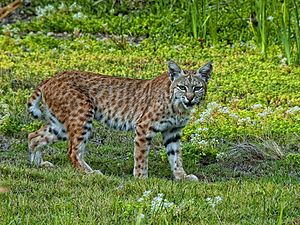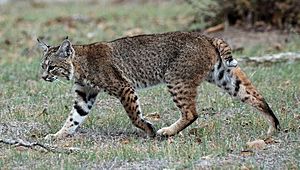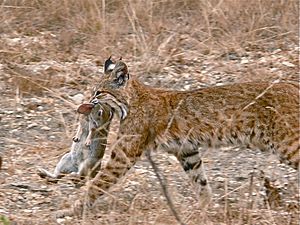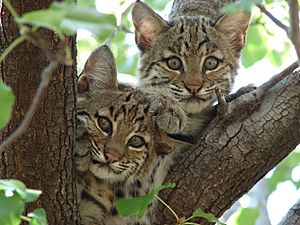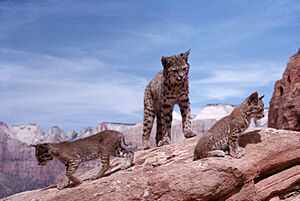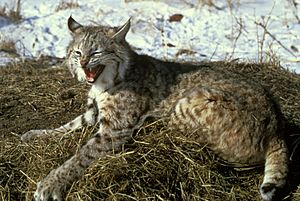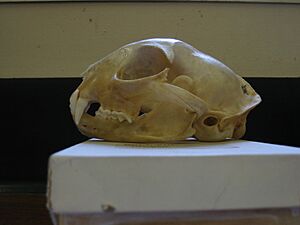Bobcat facts for kids
Quick facts for kids Bobcat |
|
|---|---|
 |
|
| Bobcat in Columbus Zoo | |
| Conservation status | |
| Scientific classification | |
 |
|
| Range in 2016 | |
| Synonyms | |
The bobcat (Lynx rufus), also known as the red lynx, is a North American wild cat.
Contents
Description
Bobcats have fur that ranges from buff to brown, sometimes with a reddish color. They have spots and stripes of brown and black on their fur, which helps them blend in with their surroundings. The fur on their bellies is lighter in color. Bobcats also have ruffs of fur on their faces, tufts on their ears, and white spots near the tips of their ears. Their short tail has black fur on top and white fur underneath. Some bobcats in Florida and New Brunswick, Canada, have even been found with black fur!
How big are they?
Bobcats are bigger than house cats but smaller than other lynx species. They usually stand about 1.5 to 2 feet (46-64 cm) tall at the shoulder. Their bodies measure about 18.7 to 49.2 inches (47.5–125 cm) long from head to tail. The tail itself is short, only about 3.5 to 7.9 inches (9 to 20 cm) long, which gives the bobcat its name. Male bobcats weigh around 14 to 40 pounds (6.4–18.3 kg), while females weigh about 8.8 to 33.7 pounds (4–15.3 kg).
Habitat

Bobcats are found all over North America, from southern Canada to Mexico. They can live in many different places, including forests, swamps, deserts, and scrublands. They are very adaptable and can even live near farms and cities if there are rocky areas, swamps, or forests nearby.
Diet
Bobcats are carnivores, which means they mainly eat meat. They like to eat rabbits and hares, but they also eat rodents like squirrels and mice. Sometimes, they will hunt larger animals like deer, as well as birds, snakes, lizards, and even small pets or chickens if they are not protected. Bobcats are excellent hunters. They can run up to 30 miles per hour (48 kilometers per hour). They are very patient and can stalk their prey for a long time before attacking. They often place their back feet in the same spots where their front feet have stepped to reduce noise when hunting.
Behavior
Bobcats are usually solitary animals, except during mating season. They are territorial and mark their territory with urine and feces. Male bobcats' territories can overlap with several females' territories, but females usually don't share territories with each other. Bobcats are most active at dawn and dusk. They spend their nights hunting and patrolling their territory, traveling anywhere from 2 to 7 miles (3 to 11 kilometers). Bobcats communicate with each other through scent, visual signals, and vocalizations. They rarely meow like house cats, but they do make chortling sounds and bird-like chirps. During mating season, they can make loud screaming sounds.
Reproduction
Bobcats mate in the winter, from November to August. After about 60 to 70 days, the female bobcat gives birth to two to four kittens. She makes a den in a protected place like a hollow tree, cave, or under a bush. The den is lined with moss and leaves to keep the kittens warm and comfortable. The mother bobcat nurses her kittens for about two months. After that, she starts bringing them prey to eat. She also teaches them how to hunt. The kittens stay with their mother for about 8 months to a year before going off to find their own territories.
Lifespan
Bobcats usually live for 5 to 15 years in the wild.
Predators
The adult bobcat has relatively few predators. Cougars and gray wolves can kill adult bobcats, a behavior repeatedly observed in Yellowstone National Park. Coyotes have killed adult bobcats and kittens. Like other Lynx species, bobcats probably avoid encounters with bears, in part because they are likely to lose kills to them or may rarely be attacked by them.
Kittens may be taken by several predators, including great horned owls, eagles, foxes, and bears, and other adult male bobcats. When prey populations are not abundant, fewer kittens are likely to reach adulthood.
Diseases, accidents, hunters, automobiles, and starvation are the other leading causes of death.
Importance in human culture
Stories featuring the bobcat, in many variations, are found in some Indigenous cultures of North America, with parallels in South America.
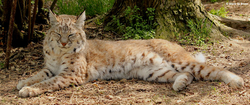
An inhabitant of Appalachia, Lynx rufus is immortalized (along with university founder Rufus Putnam) at Ohio University through its popular college mascot, Rufus the Bobcat.
Fun facts about bobcats
- Bobcats are often mistaken for other lynx species.
- They are excellent climbers and can run up to 30 miles per hour.
- They communicate through scent, visual signals, and vocalizations.
- Bobcats are crepuscular, meaning they are most active at dawn and dusk.
- The bobcat's spotted coat helps it blend in with its surroundings.
- They are able to survive for long periods without food, but they eat heavily when prey is abundant.
- Bobcats are important for controlling populations of rodents and other small animals.
See also
 In Spanish: Lince rojo para niños
In Spanish: Lince rojo para niños
- Bougar
- Canada lynx
- Eurasian lynx
- Iberian lynx



